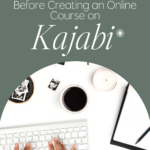
Factors to Consider Before Creating an Online Course on Kajabi
Table of Contents
ToggleSharing is caring!
Reading Time: 5 minutes


Kajabi is a business platform that helps content creators, entrepreneurs, and businesses of all sizes build, market, and sell various products online. The products vary from online courses to coaching programs, email courses, mentorship programs, and membership sites, to name a few.
If you're thinking of making an impact on your audience's life by sharing your expertise and professional insights, changing people's lives, or becoming an influencer while making passive income on the side, it's time to learn what Kajabi can do for you!
This guide will teach you how to maximize Kajabi to the fullest and create your first online course. It's easy, we promise!

What is Kajabi?
Kajabi is a business platform that lets content creators build, host, market, and sell digital products online. The service provides an “all-in-one” solution for content creators. Kajabi enables educators to develop and launch online courses of any kind to generate income from their expertise, skills, and talents.
What's so great about Kajabi is that creating an online course is easy. And this goes regardless of the course you want to make. You can piece together a comprehensive online course or a mini-course – the choice is entirely up to you!
You have to figure out what course you want to create, the price points, and what kind of content you'd like to include in the course. Kajabi will streamline everything for you, and the entire process is painless.
Try the 30-Day Trial
Kajabi offers a free trial, and if you're new to making online courses or you're looking for a better alternative to the service you're currently using, we highly suggest taking advantage of the trial version. The service adopted Netflix's multiple trial period offers; you can choose a 14-day trial, 21-day trial, and a 30-day trial – the choice is up to you. The free trial ends at a maximum of 30 days (minimum of 1 day).
Sign up for an account here, get the free trial, and play around with the features. See what functionality Kajabi offers to determine if the service is right for your needs.
If you're ready to create your first online course, here are some essential factors you need to know:
6 Factors to Consider Before Creating an Online Course on Kajabi
Hosting the Online Course
Before creating an online course, you'll need a website. If you don't have a website, you'll need to create a sales page, at the very least. The sales page will help convert readers or viewers into customers.
From the Kajabi platform, you can create a website or a sales page, but you'll have to decide how you'd like to launch and sell the online course first and foremost. Suppose you have a website but want to create a separate space for your online course. Can you do that on Kajabi? You definitely can!
Kajabi can host the online course and even take payments or communicate with your customers. Of course, you also have the choice to present the online course on your website, regardless if you're on WordPress, SquareSpace, etc., because Kajabi plays well with many hosting services.
Online Course Design
Kajabi makes putting together an online course so easy; it's almost effortless, thanks to its drag-and-drop feature. The interface is intuitive; it will walk you through much of the process so you can set up an account quickly and start creating amazing content in minutes.
You want to pay close attention to the design of the online course itself. Kajabi offers dozens of basic and branded templates. Whatever layout you choose, you have to customize it to stand out from the competition and achieve a cohesive, on-brand design. Some of the areas that you want to work on are:
- Bio and Headshot
- Layout
- Branding elements
For the bio and headshot, just write a brief description of your credentials + a nice close-up image. The description should be succinct and focused on topics that your customers want to learn.
As for the layout, there are many templates to choose from on Kajabi, and you can select one to customize. That said, you're free to use a blank canvas to create the layout design from scratch.
The branding elements will include your font style, color scheme, and customized visuals like brand logos and custom graphics. The branding elements you use on your website should be the same ones you should use on your online course for a cohesive design.
Price Point
Now that you're done designing and piecing together an online course on Kajabi, it's time to figure out how much to charge for it. If the course is broken down into a mini-course, basic course, and advanced training, you can set a total price for all or offer tiered pricing.
There's no set standard for online courses; everything will depend on your course's value, the course quality, and the amount of money your customers think the online course is worth.
Another crucial factor to consider in pricing is the payment method. Keep the payment method quick and straightforward so you don't put people off on the brink of signing up for your online course.
Thankfully, Kajabi plays well with some of the most popular online payment platforms like PayPal and Stripe. The service lets you establish recurring charges too. All of these features won't take a portion of your earnings. That means you'll receive 100% of your revenue. Now isn't that something?
Content and Structure
Your course content should start with a clear outline, so sit down, map out the modules and choose a systematic way of presenting the lessons. Take your time planning and uploading content to Kajabi to create a fully fleshed-out online course.
Once you have a detailed plan of the online course's content, you can start working on the structure of Kajabi. Every module should have a call-to-action to compel readers to finish the course and perhaps, sign up for other training courses. If possible, save your backup copies on DropBox or GoogleDrive to make the content transfer more accessible.
Copywriting and Branding
You're not just writing the actual course; you'll also create a copy for the landing page, sales page, checkout page, product page, and marketing materials. You can hire someone to do the copywriting for you or do this on your own.
You need to keep the tone in mind; your marketing materials must have the same tone as your brand's tone of voice to provide an on-brand experience. The visuals should also be on-brand. You want subscribers to receive a consistent experience with your business no matter where they interact with your brand, so keep the following consistent with your branding:
- Color scheme
- Tone of voice
- Font style
- Icons and graphics
- Logos
- Photography
When writing promotional content, think about the product's selling point. Create a benefit-driven copy, focusing on the results rather than outlining the features of the course. What is your key message? What are you trying to achieve with your marketing campaign? How can your online course help customers? The answers to these questions will be the foundation of your marketing copy.
Core Audience
Your online course will attract a targeted audience, so the content and design should be created with these specific groups of people in mind. To increase signups, you must create marketing messages that resonate with your ideal client's pain points. You need to highlight the solution that the online course offers and build content around it – blogs, video content, social media posts, podcasts, etc.
To grow your email list, you must create an attractive lead magnet. A freebie, access to a mini-course, a promo code, etc. – any of these could be used to promote your online course and attract your ideal customer.
Again, create benefit-focused content to make an impact. Set the promotional campaign to several weeks before the launch, starting with a targeted email campaign in a drip format. Marketing can be automated in Kajabi, so you can focus on creating amazing copies for promotions and then let the platform handle the rest.
Growing your email list and attracting more signups for your online course is infinitely easier with Kajabi. Try the service today and start creating your first online course!
Most Popular Posts:
Sharing is caring!
[…] online courses could contain video tutorials, and though some find this content convenient, others do not like […]